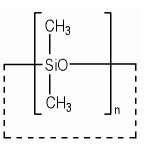Cyclomethicone (decamethylcyclopentasiloxane) is a chemical compound invented in 1980 by Dow Corning, a mixture of cyclic dimethyl polysiloxane compounds.
The name "Cyclomethicone" describes the structure of the molecule.
- "Cyclo" refers to the cyclic (ring) structure of the molecule,
- "meth" refers to the presence of methyl groups (-CH3), and
- "siloxane" refers to the type of silicone compound that is, characterized by alternating silicon and oxygen atoms.
The synthesis process takes place in several stages:
- Step 1 - Production of chlorsilanes by the reaction of elemental silicon with methyl chloride (CH3Cl) at high temperatures in the presence of a copper catalyst that produces various chlorsilanes, including Dimethyldichlorosilane (CH3)2SiCl2.
- Step 2 - Hydrolysis- Dimethyldichlorosilane is hydrolysed (reacted with water) to produce a mixture of linear and cyclic siloxanes, together with hydrochloric acid (HCl).
- Step 3 - Cyclization. The mixture is heated under vacuum to promote the formation of cyclic siloxanes, including Decamethylcyclopentasiloxane. The cyclic siloxanes are then separated from the linear siloxanes by distillation.
- Step 4 - Purification. Decamethylcyclopentasiloxane is purified, with further distillation, to remove all remaining impurities.

Silicones possess high chemical stability, but low biodegradability and high bioaccumulation potential.
Safety
It is an ingredient with high bioaccumulation and persistence as well as non-reproductive organ toxicity properties (1). Prohibited in cosmetics if it contains silicone D4. However, when used in cosmetic products, Cyclomethicone is considered a safe ingredient (2).
What it is used for and where
It is a colourless, odourless liquid known for its silky smooth texture and its ability to evaporate quickly without leaving a residue. Cyclomethicone is used in a variety of products, including hairsprays, skin moisturisers and make-up, because it helps deliver other ingredients into the skin and hair. It also provides a silky, smooth feel to products and helps reduce the greasy feel of heavier oils.
Cosmetics
- Hair conditioning agent. A large number of ingredients with specific purposes can co-exist in a hair shampoo: cleansers, conditioners, thickeners, mattifying agents, sequestering agents, fragrances, preservatives, special additives. However, the indispensable ingredients are the cleansers and conditioners as they are necessary and sufficient for hair cleansing and manageability. The others act as commercial and non-essential auxiliaries such as: appearance, fragrance, colouring, etc. Hair conditioning agents have the task of increasing shine, manageability and volume, and reducing static electricity, especially after treatments such as colouring, ironing, waving, drying and brushing. They are, in practice, dispersing agents that may contain cationic surfactants, thickeners, emollients, polymers. The typology of hair conditioners includes: intensive conditioners, instant conditioners, thickening conditioners, drying conditioners.
- Skin conditioning agent - Emollient. Emollients have the characteristic of enhancing the skin barrier through a source of exogenous lipids that adhere to the skin, improving barrier properties by filling gaps in intercorneocyte clusters to improve hydration while protecting against inflammation. In practice, they have the ability to create a barrier that prevents transepidermal water loss. Emollients are described as degreasing or refreshing additives that improve the lipid content of the upper layers of the skin by preventing degreasing and drying of the skin. The problem with emollients is that many have a strong lipophilic character and are identified as occlusive ingredients; they are oily and fatty materials that remain on the skin surface and reduce transepidermal water loss. In cosmetics, emollients and moisturisers are often considered synonymous with humectants and occlusives.
- Solvent. It is the substance for dissolving or dispersing surfactants, oils, dyes, flavourings, bactericidal preservatives in solution.

- Molecular Formula: C10H30O5Si5
- Molecular Weight: 370.77 g/mol
- CAS: 541-02-6 69430-24-6
- EC Number: 208-764-9
- UNIII: 0THT5PCI0R
- Beilstein Registry Number:1800166
- MDL number: MFCD00046966
- PubChem Substance ID: 24868110
Synonyms:
- Cyclotetrasiloxane
- Octamethylcyclotetrasiloxane
- Decamethylcyclopentasiloxane
- Cyclopentasiloxane, decamethyl-
- Dimethylsiloxane pentamer
- Cyclic dimethylsiloxane pentamer
- Dekamethylcyklopentasiloxan
References_____________________________________________________________________
(1) Goussard, V., Aubry, J. M., & Nardello-Rataj, V. (2022). Bio-based alternatives to volatile silicones: Relationships between chemical structure, physicochemical properties and functional performances. Advances in Colloid and Interface Science, 102679.
(2) Opinion of the Scientific Committee on Consumer Safety on cyclomethicone (D4/D5) (europa.eu)
![]() Cyclomethicone
Cyclomethicone 



